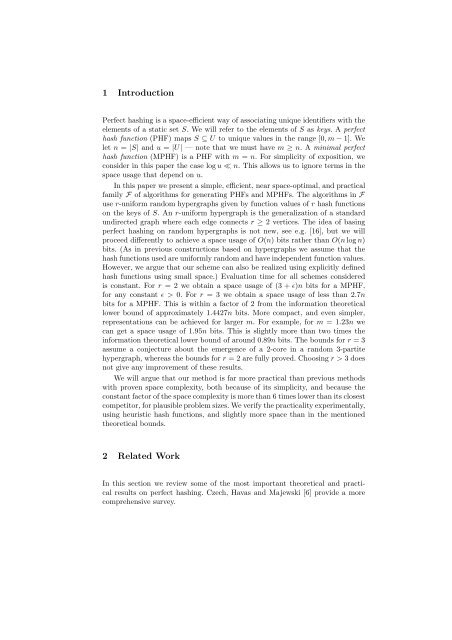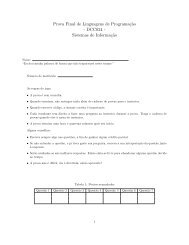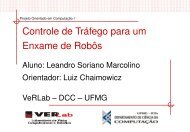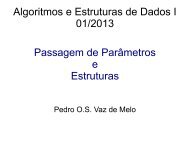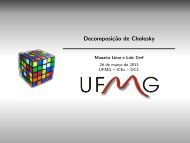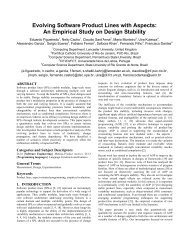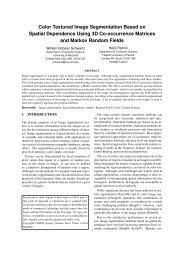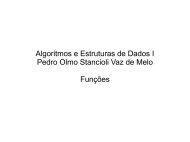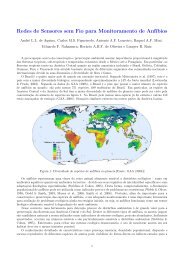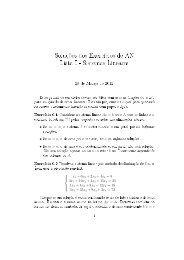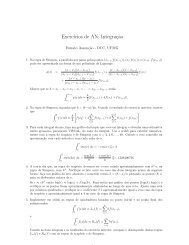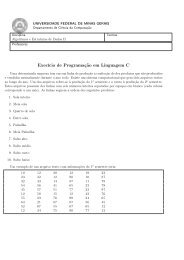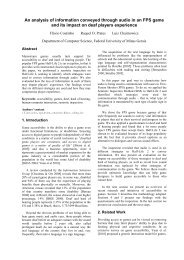Simple and Space-Efficient Minimal Perfect Hash Functions * - Liacs
Simple and Space-Efficient Minimal Perfect Hash Functions * - Liacs
Simple and Space-Efficient Minimal Perfect Hash Functions * - Liacs
Create successful ePaper yourself
Turn your PDF publications into a flip-book with our unique Google optimized e-Paper software.
1 Introduction<br />
<strong>Perfect</strong> hashing is a space-efficient way of associating unique identifiers with the<br />
elements of a static set S. We will refer to the elements of S as keys. A perfect<br />
hash function (PHF) maps S ⊆ U to unique values in the range [0, m − 1]. We<br />
let n = |S| <strong>and</strong> u = |U| — note that we must have m ≥ n. A minimal perfect<br />
hash function (MPHF) is a PHF with m = n. For simplicity of exposition, we<br />
consider in this paper the case log u ≪ n. This allows us to ignore terms in the<br />
space usage that depend on u.<br />
In this paper we present a simple, efficient, near space-optimal, <strong>and</strong> practical<br />
family F of algorithms for generating PHFs <strong>and</strong> MPHFs. The algorithms in F<br />
use r-uniform r<strong>and</strong>om hypergraphs given by function values of r hash functions<br />
on the keys of S. An r-uniform hypergraph is the generalization of a st<strong>and</strong>ard<br />
undirected graph where each edge connects r ≥ 2 vertices. The idea of basing<br />
perfect hashing on r<strong>and</strong>om hypergraphs is not new, see e.g. [16], but we will<br />
proceed differently to achieve a space usage of O(n) bits rather than O(n log n)<br />
bits. (As in previous constructions based on hypergraphs we assume that the<br />
hash functions used are uniformly r<strong>and</strong>om <strong>and</strong> have independent function values.<br />
However, we argue that our scheme can also be realized using explicitly defined<br />
hash functions using small space.) Evaluation time for all schemes considered<br />
is constant. For r = 2 we obtain a space usage of (3 + ǫ)n bits for a MPHF,<br />
for any constant ǫ > 0. For r = 3 we obtain a space usage of less than 2.7n<br />
bits for a MPHF. This is within a factor of 2 from the information theoretical<br />
lower bound of approximately 1.4427n bits. More compact, <strong>and</strong> even simpler,<br />
representations can be achieved for larger m. For example, for m = 1.23n we<br />
can get a space usage of 1.95n bits. This is slightly more than two times the<br />
information theoretical lower bound of around 0.89n bits. The bounds for r = 3<br />
assume a conjecture about the emergence of a 2-core in a r<strong>and</strong>om 3-partite<br />
hypergraph, whereas the bounds for r = 2 are fully proved. Choosing r > 3 does<br />
not give any improvement of these results.<br />
We will argue that our method is far more practical than previous methods<br />
with proven space complexity, both because of its simplicity, <strong>and</strong> because the<br />
constant factor of the space complexity is more than 6 times lower than its closest<br />
competitor, for plausible problem sizes. We verify the practicality experimentally,<br />
using heuristic hash functions, <strong>and</strong> slightly more space than in the mentioned<br />
theoretical bounds.<br />
2 Related Work<br />
In this section we review some of the most important theoretical <strong>and</strong> practical<br />
results on perfect hashing. Czech, Havas <strong>and</strong> Majewski [6] provide a more<br />
comprehensive survey.


